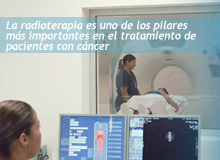Treatments
Radiotherapy is one of the most important foundations in the treatment of patients with cancer. It is based in the production of ionizing radiation by means of X-rays or radioactive materials.
- RapidArc
RapidArc technology is a great advance capable of improving treatment compliance while reducing treatment’s length at the same time. RapidArc delivers treatment 2 to 8 times faster than “dynamic procedures” available in current markets.
RapidArc is a Volumetric Arc’s therapy, capable of three-dimension sculpting, thus distributing doses in a single 360 degrees rotation of the Lineal Accelerator. That’s possible because calculated algorithms changes three parameters simultaneously:
- Lineal Accelerator’s rotation speed.
- Aperture’s shape using the movement of a Multileaf Collimator.
- The dose rate.
Volumetric Arc Therapy differentiates itself from prior techniques, like Helicoidal IMRT or Modulated Intensity Arc Therapy, because it delivers the dosage to a complete volume instead of doing it section by section. The more important distinctiveness is that the calculated algorithm guarantees the precision of the treatment while protecting healthy organs.
RapidArc Benefits
Total treatment time of under three minutes. Several studies have shown that just a single Arc is as good or equally effective as a treatment of several fields with IMRT, taking into account the tumor coverage and the healthy tissues’ protection.
IMRT
Intensity-modulated radiotherapy (IMRT) paints the tumor with a high-precision dosage. The ability to preserve healthy tissues surrounding a tumor, using this technique, is so impressive doctors around the world are employing it to treat almost any kind of solid tumor.
IMRT in an extraordinary method for the treatment of cancer and for the improvement of the quality of life of the patients, during treatment as well as afterwards.
IMRT Benefits
- The ability to deliver high doses directly on the tumor, while protecting healthy organs surrounding it.
- The application of lower doses to healthy tissues translates into fewer complications and less side effects.
- The possibility to treat cancers previously unabled to be treated with radiotherapy.
- It is a non-invasive alternative to surgery in many cases.
- It focuses on the tumor and not on the whole body.
IGRT
Image-Guided Radiation Therapy (IGRT) is based on the movement that takes place during treatment, in order to guarantee the target volume remains always in the same place. Radiographic images, fluoroscopy and cone-beam CT are automatically integrated to the Reposition & Motion Control software during IGRT treatments. This technology allows physicians to make certain all treatments are indeed completely synchronized with patients´ breathing patterns.
IGRT produces high-resolution tri-dimensional images for locating the tumor, adjust positioning when needed and complete the treatment in the expected scheduled time. This technology takes IMRT treatment one-step forward, increasing the patients’ quality care while improving the treatment effectiveness.
Brachytherapy
High Dose Rate (HDR) Brachytherapy is applied with a microSelectron of an 18-channels system, supported by an Oncentra Planning System; both from the same brand name, Nucletron.
Treatments usually requires no hospitalization time and the administration last only a few minutes. Such treatments can be interstitial, intracavitary or intraluminal, in order to introduce radioactive sources inside the patient’s body and directly over the area affected by the tumor, while effectively safeguarding the adjacent organs.
For low dose treatments (LDR) also known as “permanent implantation of seeds in the prostate”, we own a transrectal-ultrasound brand Best Medical Systems USA, which produces images along with a General Electric High Resolution C-Arm, for the insertion of needles, through which the seeds (Iodine 125) will be placed into the prostate. The needles will be charged with radioactive sources, thereafter are fixed to a template to be placed around the perineal area in a transductor to be introduced interstitially into the patient, which makes necessary the use of local anesthesia. The whole process will take about 2 hours and the patient will be able to go back to his home that same day to begin his recovery period. In properly selected patients or in cases of recurrent tumors in different parts of the body, this technique may also be followed.
.png)

